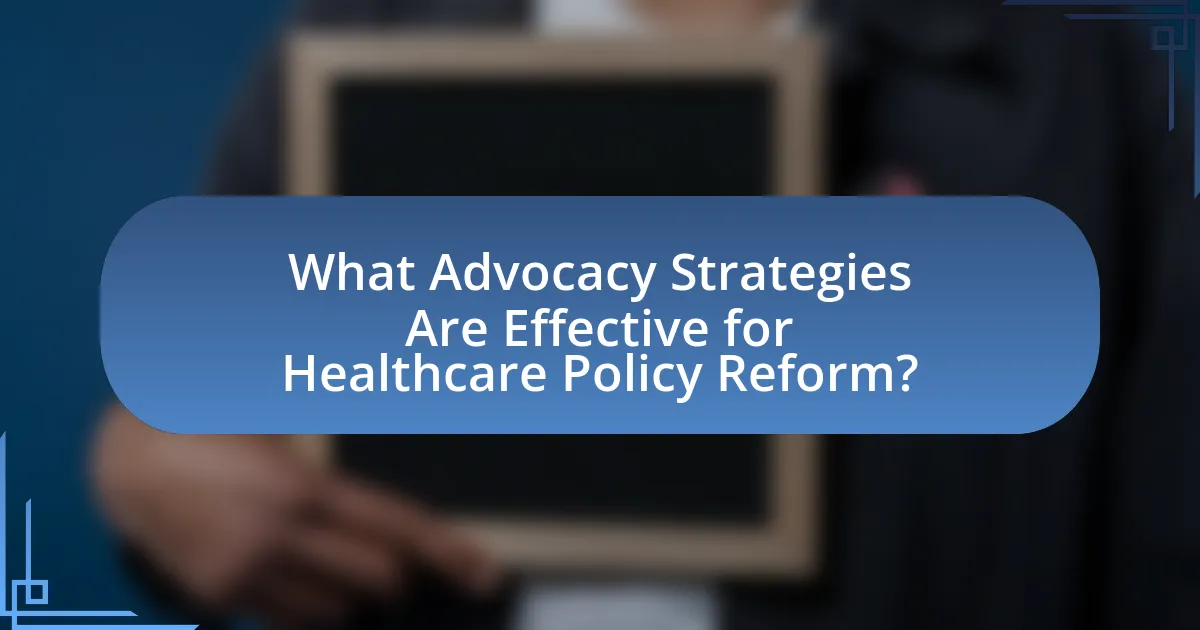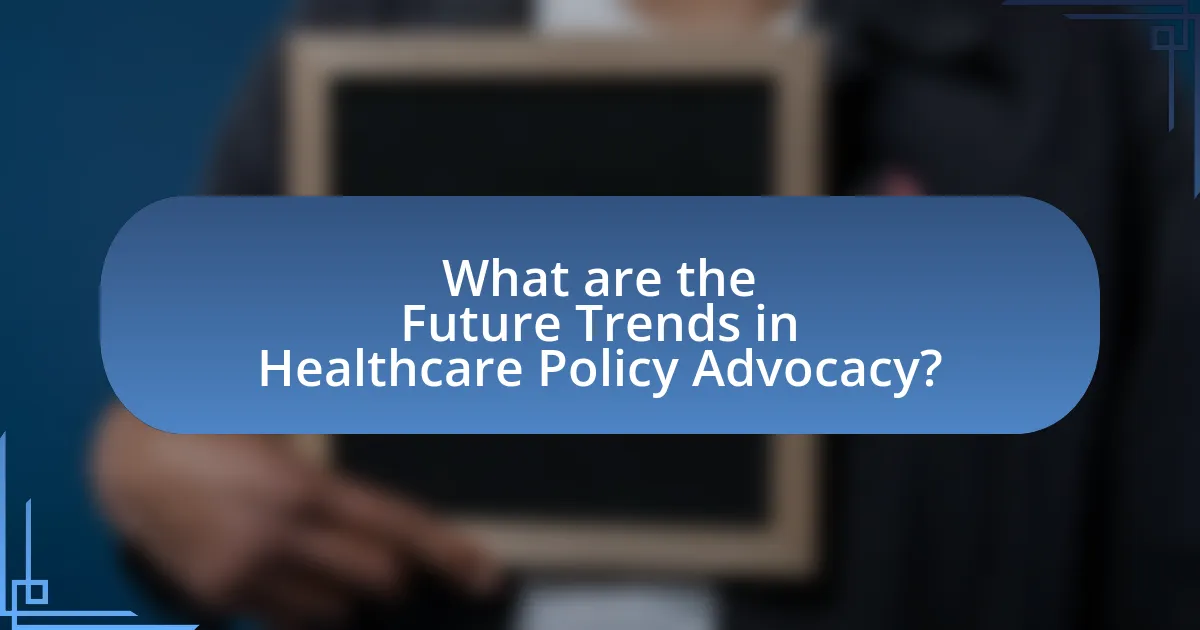The article focuses on the future of healthcare policy reform, emphasizing the importance of advocacy strategies that effectively address accessibility, affordability, and quality of care. It outlines the evolution of healthcare policy towards value-based care, the impact of technological advancements like telehealth, and the necessity of addressing social determinants of health. Key drivers of reform include rising costs, demographic changes, and public demand for equitable access. The article also highlights effective advocacy strategies, such as grassroots mobilization and data-driven approaches, while discussing the role of stakeholders and the influence of technology in shaping future healthcare policies.

What is the Future of Healthcare Policy Reform?
The future of healthcare policy reform is likely to focus on increasing accessibility, affordability, and quality of care through innovative models and technology integration. Policymakers are expected to prioritize value-based care, which emphasizes patient outcomes over service volume, as evidenced by the shift in Medicare reimbursement models towards rewarding quality rather than quantity. Additionally, the rise of telehealth and digital health solutions is anticipated to reshape service delivery, making healthcare more accessible, particularly in underserved areas. According to a report by the American Hospital Association, telehealth usage surged by 154% during the COVID-19 pandemic, highlighting its potential role in future healthcare delivery. Furthermore, advocacy for social determinants of health will likely gain momentum, as addressing factors like housing, education, and nutrition is essential for improving overall health outcomes.
How is healthcare policy reform evolving in the current landscape?
Healthcare policy reform is evolving through increased emphasis on equity, accessibility, and technology integration. Recent trends indicate a shift towards value-based care models, which prioritize patient outcomes over service volume, as evidenced by the Centers for Medicare & Medicaid Services’ initiatives that incentivize quality over quantity. Additionally, the COVID-19 pandemic has accelerated telehealth adoption, leading to policy changes that support remote care access, as seen in the temporary waivers and permanent expansions of telehealth services by various states. These developments reflect a broader commitment to addressing disparities in healthcare access and improving overall system efficiency.
What are the key drivers behind healthcare policy reform?
The key drivers behind healthcare policy reform include rising healthcare costs, demographic changes, technological advancements, and the demand for improved quality of care. Rising healthcare costs have prompted policymakers to seek more efficient systems, as evidenced by the U.S. spending over $4 trillion on healthcare in 2020, which is approximately 18% of the GDP. Demographic changes, such as an aging population, necessitate reforms to address the increasing prevalence of chronic diseases. Technological advancements, including telemedicine and electronic health records, are reshaping service delivery and access, driving the need for updated policies. Lastly, the public’s demand for improved quality of care and equitable access to services has led to advocacy for reforms that prioritize patient-centered approaches.
How do technological advancements influence healthcare policy?
Technological advancements significantly influence healthcare policy by driving the need for updated regulations and frameworks that address new innovations. For instance, the rise of telemedicine has prompted policymakers to create guidelines that ensure patient privacy and reimbursement for virtual consultations, reflecting the shift in how healthcare services are delivered. Additionally, advancements in data analytics and artificial intelligence have led to the development of policies focused on data security and ethical use of patient information, as seen in the implementation of the Health Insurance Portability and Accountability Act (HIPAA) in the United States. These examples illustrate how technology not only shapes healthcare delivery but also necessitates corresponding policy adaptations to ensure safety, accessibility, and efficiency in the healthcare system.
Why is healthcare policy reform essential for the future?
Healthcare policy reform is essential for the future to ensure equitable access to quality care, improve health outcomes, and control rising costs. Current healthcare systems often exhibit disparities in access and quality, leading to significant health inequities among different populations. For instance, a report from the National Academy of Medicine indicates that social determinants of health contribute to a 20-year difference in life expectancy between the richest and poorest communities in the United States. Reforming healthcare policies can address these disparities by implementing universal coverage, enhancing preventive care, and promoting value-based care models, which have been shown to improve patient outcomes while reducing overall healthcare spending.
What challenges does the current healthcare system face?
The current healthcare system faces significant challenges, including rising costs, access disparities, and inefficiencies in care delivery. Rising healthcare costs have outpaced inflation, with U.S. healthcare spending reaching approximately $4.1 trillion in 2020, accounting for nearly 20% of the GDP. Access disparities are evident, as millions remain uninsured or underinsured, leading to inequitable health outcomes. Additionally, inefficiencies in care delivery, such as fragmented services and administrative burdens, contribute to suboptimal patient experiences and outcomes. These challenges necessitate comprehensive policy reform to enhance the effectiveness and equity of healthcare systems.
How can policy reform address disparities in healthcare access?
Policy reform can address disparities in healthcare access by implementing equitable funding models and expanding insurance coverage. For instance, reforms that increase Medicaid expansion in low-income areas have been shown to improve access to healthcare services, as evidenced by a study published in the Journal of the American Medical Association, which found that states expanding Medicaid saw a 7% increase in access to care. Additionally, policies that promote telehealth services can bridge gaps for underserved populations, as demonstrated by a report from the American Hospital Association indicating that telehealth usage increased by 154% during the COVID-19 pandemic, providing critical access to healthcare for those in remote areas.

What Advocacy Strategies Are Effective for Healthcare Policy Reform?
Effective advocacy strategies for healthcare policy reform include grassroots mobilization, coalition building, and data-driven advocacy. Grassroots mobilization engages community members to raise awareness and influence policymakers through organized campaigns, as seen in the successful efforts of the Affordable Care Act, which relied heavily on public support. Coalition building brings together diverse stakeholders, such as healthcare providers, patients, and advocacy groups, to create a unified front, exemplified by the collaboration of various organizations during the push for mental health parity legislation. Data-driven advocacy utilizes research and statistics to support policy proposals, demonstrating the impact of reforms on health outcomes and costs, as evidenced by studies showing that expanding Medicaid reduces hospital readmissions. These strategies collectively enhance the effectiveness of advocacy efforts in achieving meaningful healthcare policy reform.
How can stakeholders influence healthcare policy changes?
Stakeholders can influence healthcare policy changes through advocacy, lobbying, and collaboration with policymakers. Advocacy efforts, such as public campaigns and grassroots mobilization, raise awareness about specific healthcare issues, thereby shaping public opinion and prompting legislative action. Lobbying involves direct interaction with legislators to present data and arguments that support particular policy changes, which can lead to the introduction of new laws or amendments to existing ones. Collaboration with policymakers, including participation in advisory committees or public forums, allows stakeholders to provide expert insights and recommendations that can inform policy decisions. For example, the American Medical Association has successfully influenced healthcare policy by advocating for physician interests and providing evidence-based recommendations to Congress.
What role do grassroots movements play in advocacy?
Grassroots movements play a crucial role in advocacy by mobilizing community members to influence policy change from the ground up. These movements empower individuals to voice their concerns, organize collective actions, and engage in lobbying efforts, thereby amplifying their impact on decision-makers. For instance, the grassroots campaign for the Affordable Care Act involved numerous local organizations that educated citizens, gathered support, and pressured legislators, demonstrating how grassroots efforts can effectively shape healthcare policy.
How can data and research support advocacy efforts?
Data and research support advocacy efforts by providing evidence-based insights that strengthen arguments and influence policy decisions. For instance, studies such as “The Impact of Evidence-Based Advocacy on Health Policy” published in the Journal of Health Politics, Policy and Law demonstrate that data-driven advocacy can lead to more effective healthcare reforms. By presenting statistics on health outcomes, cost-effectiveness, and demographic needs, advocates can effectively communicate the urgency of their causes, thereby mobilizing public support and persuading policymakers to act.
What are the best practices for healthcare advocacy?
The best practices for healthcare advocacy include building strong relationships with policymakers, utilizing data-driven arguments, and engaging the community effectively. Strong relationships with policymakers facilitate open communication and influence decision-making processes, as evidenced by successful advocacy campaigns that have led to policy changes. Data-driven arguments, supported by statistics and research, enhance credibility and persuade stakeholders; for instance, studies show that advocacy efforts backed by solid data are more likely to result in legislative support. Engaging the community through outreach and education fosters grassroots support, which is crucial for amplifying advocacy efforts, as demonstrated by initiatives that mobilize public opinion to drive healthcare reforms.
How can effective communication enhance advocacy strategies?
Effective communication enhances advocacy strategies by ensuring that messages are clear, persuasive, and tailored to the audience. When advocates articulate their goals and the importance of their cause effectively, they can mobilize support, influence policymakers, and engage stakeholders. Research shows that campaigns with strong communication strategies, such as the “Truth” campaign against smoking, have significantly reduced youth smoking rates by 22% over a decade, demonstrating the power of targeted messaging. Thus, effective communication is crucial for successful advocacy in healthcare policy reform.
What partnerships are crucial for successful advocacy?
Crucial partnerships for successful advocacy include collaborations with grassroots organizations, healthcare professionals, policymakers, and community leaders. Grassroots organizations mobilize community support and amplify voices, while healthcare professionals provide expertise and credibility to advocacy efforts. Policymakers are essential for enacting change, as they have the authority to implement reforms. Community leaders help to engage local populations and ensure that advocacy efforts are relevant and impactful. Research shows that effective coalitions can increase the likelihood of policy change by up to 50%, demonstrating the importance of these partnerships in achieving advocacy goals.

What are the Future Trends in Healthcare Policy Advocacy?
Future trends in healthcare policy advocacy include increased use of data analytics, a focus on health equity, and the integration of technology in advocacy efforts. Data analytics allows advocates to identify and address specific health disparities, while a focus on health equity ensures that policies consider the needs of marginalized populations. Additionally, technology, such as social media and telehealth platforms, enhances outreach and engagement, enabling advocates to mobilize support more effectively. These trends are supported by the growing recognition of social determinants of health and the need for comprehensive policy solutions that address systemic issues in healthcare access and quality.
How is technology shaping the future of healthcare advocacy?
Technology is significantly shaping the future of healthcare advocacy by enhancing communication, data accessibility, and patient engagement. Digital platforms enable advocates to reach broader audiences, facilitating real-time information sharing and mobilization around healthcare issues. For instance, social media campaigns have proven effective in raising awareness and influencing public opinion, as seen in movements like #MedicareForAll, which gained traction through online advocacy. Additionally, telehealth technologies improve access to care, allowing advocates to address disparities in healthcare access and promote policy changes that support underserved populations. According to a 2021 report by the Pew Research Center, 46% of U.S. adults have used telehealth services, highlighting the growing reliance on technology in healthcare advocacy efforts.
What digital tools are emerging for advocacy campaigns?
Emerging digital tools for advocacy campaigns include social media platforms, mobile apps, and data analytics software. Social media platforms like Twitter and Facebook facilitate real-time engagement and mobilization of supporters, allowing campaigns to reach wider audiences quickly. Mobile apps enable grassroots organizing and provide users with tools to contact legislators directly, enhancing participation. Data analytics software helps organizations analyze public sentiment and target messaging effectively, improving campaign strategies. These tools are increasingly vital as they leverage technology to enhance communication and engagement in advocacy efforts.
How can social media amplify advocacy efforts?
Social media can amplify advocacy efforts by increasing visibility and engagement for causes. Platforms like Twitter, Facebook, and Instagram allow advocates to reach a broader audience quickly, facilitating the sharing of information and mobilizing support. For instance, the #MeToo movement gained significant traction through social media, leading to widespread awareness and policy discussions around sexual harassment. Additionally, studies show that social media campaigns can enhance participation in advocacy events, with a 2019 report indicating that 70% of participants in social movements were influenced by social media interactions. This demonstrates that social media not only spreads messages but also fosters community and action among supporters.
What lessons can be learned from past advocacy efforts?
Past advocacy efforts demonstrate the importance of coalition-building and grassroots mobilization in achieving policy change. Successful campaigns, such as the American Cancer Society’s push for tobacco control, highlight that diverse stakeholder engagement amplifies voices and increases pressure on policymakers. Additionally, data-driven approaches, as seen in the Affordable Care Act advocacy, show that presenting clear evidence of benefits can sway public opinion and legislative support. These lessons underscore the need for strategic communication and sustained engagement to influence healthcare policy effectively.
What successful case studies exist in healthcare policy reform?
Successful case studies in healthcare policy reform include the Affordable Care Act (ACA) in the United States, which expanded health insurance coverage to over 20 million Americans and implemented key provisions like the prohibition of denying coverage due to pre-existing conditions. Another notable example is the National Health Service (NHS) in the United Kingdom, which established a publicly funded healthcare system that provides comprehensive services to all residents, significantly improving health outcomes and access to care. Additionally, the implementation of the Health and Social Care Act in 2012 in England aimed to increase efficiency and patient choice within the NHS, demonstrating a shift towards more localized decision-making in healthcare delivery. These case studies illustrate effective strategies in expanding access, improving quality, and reforming healthcare systems.
How can failures inform future advocacy strategies?
Failures can inform future advocacy strategies by providing critical insights into what approaches did not resonate with stakeholders or achieve desired outcomes. Analyzing past failures allows advocates to identify gaps in messaging, engagement, or policy alignment, which can be adjusted in future campaigns. For instance, the failure of the Affordable Care Act’s initial rollout highlighted the importance of clear communication and stakeholder involvement, leading to more inclusive strategies in subsequent healthcare reforms. By learning from these missteps, advocates can refine their tactics, enhance their understanding of the political landscape, and ultimately increase the effectiveness of their efforts in influencing policy change.
What practical steps can individuals take to advocate for healthcare policy reform?
Individuals can advocate for healthcare policy reform by engaging in grassroots organizing, contacting elected officials, and participating in public forums. Grassroots organizing involves mobilizing community members to raise awareness about healthcare issues, which can lead to collective action and influence policy decisions. Contacting elected officials through letters, emails, or phone calls allows individuals to express their concerns and advocate for specific reforms, as studies show that direct communication can significantly impact lawmakers’ priorities. Participating in public forums, such as town hall meetings or community discussions, provides a platform for individuals to voice their opinions and connect with others who share similar goals, fostering a collaborative environment for advocacy.


